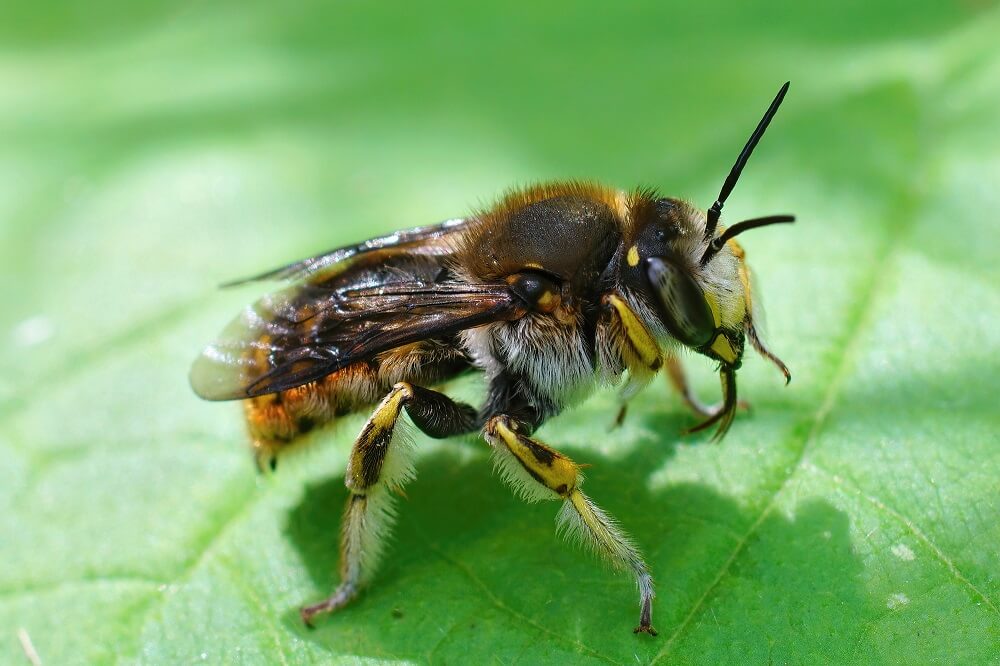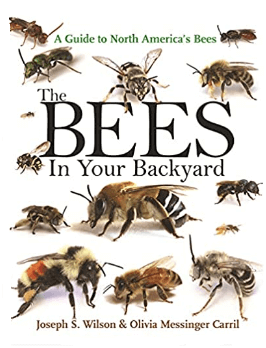Table of Contents:
Do Bees Sleep?
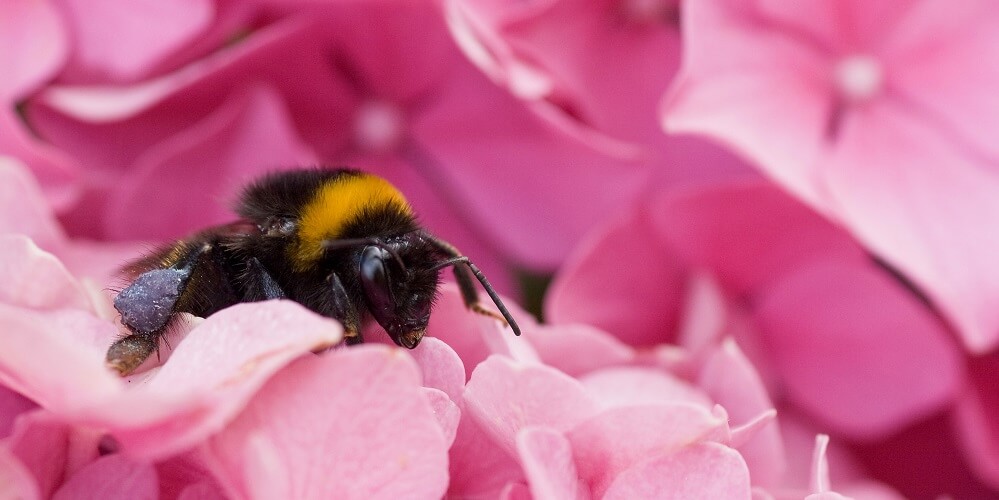
Yes, bees sleep.
And guess what?
It might surprise you to learn that bees can start showing signs of sleep deprivation if they don’t get enough sleep. Bees need a good night’s sleep just like humans do.
But how do we know this for sure?
Because researcher Walter Kaiser published the first study on sleeping bees in the 1980s. He discovered that honeybees slept an average of 5 to 7 hours per night.(1, 2, 3)
Now you may be wondering how to tell if bees are sleeping.
Simple.
A tired bee’s antennae and wings will stop moving, and they’ll tuck their head and tail in. And as they drift off to sleep, their body temperature will drop slightly.
Check out this sleeping honeybee:
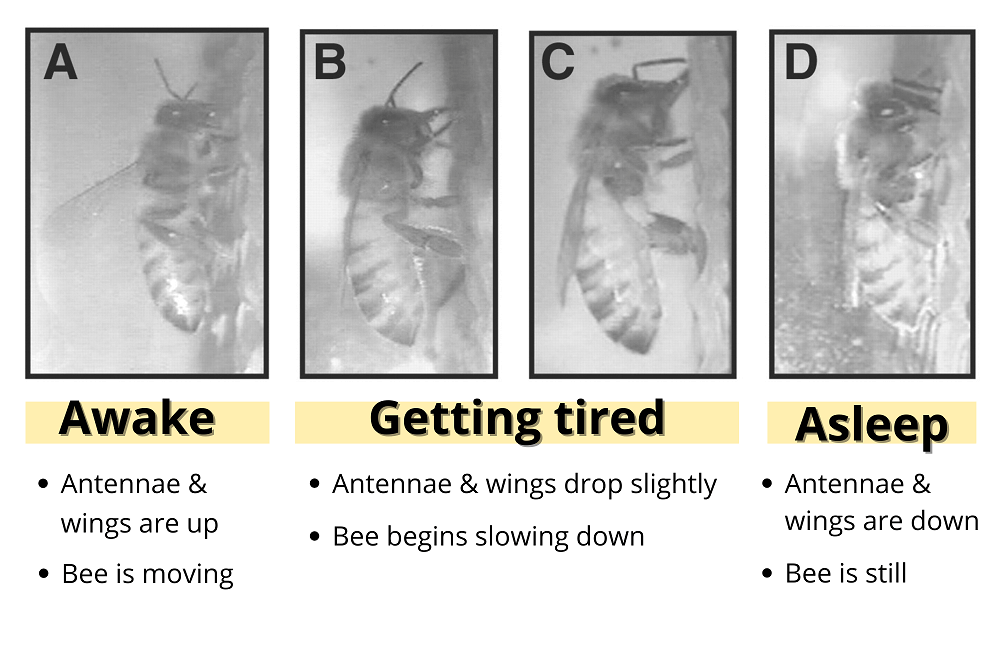
Related: How Many Legs Do Bees Have?
Where Do Bees Sleep?
Most bees sleep inside their nests.
For honeybees, this often means they sleep inside a beeswax cell or in a quiet corner of the hive.

But not all bees share the same sleeping schedule.
For example, forager honeybees are the ones that fly outside of the hive to gather nectar and pollen. Their foraging schedule requires them to be active during the day. So naturally, this means they sleep at night.(4)
In contrast, young worker bees are the ones who clean the hive. Unlike forager honeybees, the younger bees don’t have a fixed sleep schedule. Instead, they tend to take short naps throughout the day between working “shifts.”
This allows the young worker bees to get some work done both day and night.
Related: How Many Eyes Does a Bee Have?
What Time Do Bees Sleep and Wakeup?

It depends on the bee.
Take humans, for example.
Some people are night owls, so they feel more energized in the evening. Other people are early birds and wake up at the crack of dawn.
Bees are similar. It just depends on what their role is in the hive.
Remember:
Bees that work outside of the hive foraging for food need a set sleep schedule.
Why?
Because most bees only gather nectar and pollen during the daytime. This is when flowers are open and ready for pollination.

Forager bees only have a limited amount of daylight hours. So as the sun rises in the morning, it’s their “alarm clock” to get busy. Once the sun sets, it’s their time to make it back home and get some rest.
But here’s the thing:
Not all bees are social bees.
In fact, most bees are solitary bees that don’t live in hives. For example, female mason bees are solitary bees. This means they build their own nest, lay their own eggs, and forage for their own nectar and pollen.
In other words?
Solitary bees perform all the roles. They have little to no help.
Sounds like a lot, doesn’t it?
True. But at the same time, solitary bees don’t have large hives to maintain like honeybees do.
You see, honeybees can have hives as large as 60,000 bees. These huge hives demand a lot of resources to build comb, make honey, and lay enough eggs to maintain that population.
So honeybee hives are a well-oiled machine where there’s always something that needs to be done. That’s why some honeybees work at night, while others work during the day.
But remember:
Honeybees need sleep too. So even if some of the honeybees work at night, they’ll make up for it by taking naps when needed.
Related: Do Bees Have Lungs?
Can Bees Become Sleep Deprived?
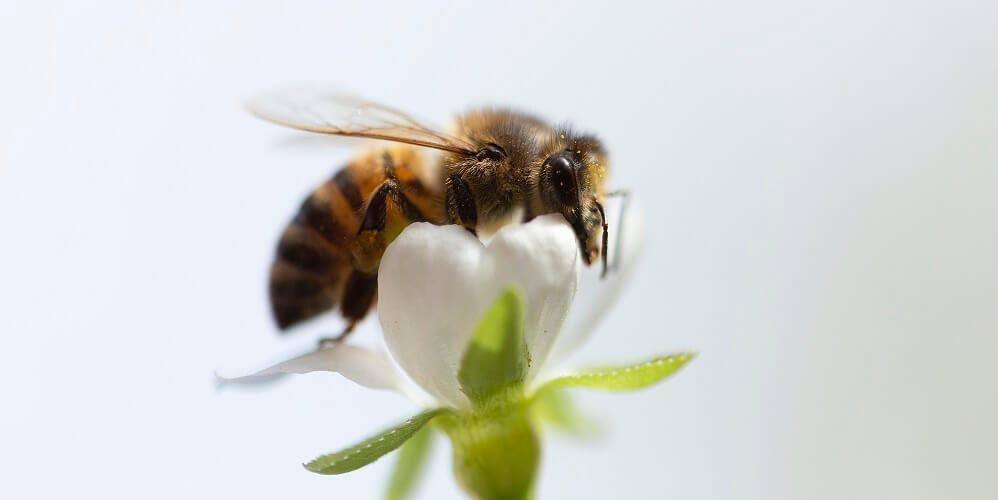
Yes, they can.
This is another similarity we share with bees. If you don’t get enough sleep, you’ll feel sluggish and have trouble performing daily tasks. Your eyes might start feeling heavy, and you’ll find yourself dozing off.
Bees are no different.
Their productivity takes a hit if they don’t get proper sleep. For example, scientists found that sleep-deprived bees:
- Have trouble learning new routes back to their hive
- Show signs of exhaustion during the day, such as being sluggish and moving their antennae less
- Weren’t able to perform their waggle dance, which is how honeybees communicate with each other
Related: How Long Do Bees Live?
FAQs on “Do Bees Sleep?”
- Do bees take naps?
- Do bees sleep together?
- Can I learn how to tell if a bee is sleeping or dead?
- Do bees sleep in the winter?
- What time do bees go to sleep?
- What time do bees wake up?
- Do bees sleep in flowers?
- Do carpenter bees sleep at night?
- Does smoke make bees sleep?
Do bees take naps?
Yes.
Bees are known for being hard workers that never take days off. But like humans, bees need sleep to be productive and put their best foot forward.
But not all bees conform to a circadian rhythm like humans do (sleep at night, active during the day). A bee’s sleeping patterns depend on its job responsibilities.
For example, forager bees tend to sleep at night. This is because their job duty is to gather pollen and nectar during the day while the flower blooms are open.
Because forager bees sleep throughout the night, they tend to sleep around the edges of the hive. This allows them to rest peacefully away from the chaotic activity in the center of the hive.
Younger worker bees that work inside of the hive are the opposite. They work day and night, with irregular naps in between. They don’t have a set sleep schedule like forager bees do.
Napping bees also go through sleep phases, such as light and deep sleep.
—> Go back to the FAQs on “Do Bees Sleep?”
More to Explore:
Do bees sleep together?
Not always.
That said, bees that live in hives will sleep next to each other, but they don’t always hold each other or cuddle together.
Solitary bees live alone, so they don’t sleep with other bees for obvious reasons. In fact, most bees are solitary bees that live underground. They dig holes in the dirt for their nests or they’ll find empty burrows left behind by rodents.
Honeybees and bumblebees are different. They’re examples of social bees that live in hives where each bee performs a specific role.
—> Go back to the FAQs on “Do Bees Sleep?”
More to Explore:
Can I learn how to tell if a bee is sleeping or dead?
I get this question often.
I think it’s partly because there are various pictures online of bees “sleeping” inside flowers. So it has people curious about how to tell if a bee is sleeping.
Well, the answer to “How can you tell if a bee is sleeping?” isn’t black and white.
Here’s the thing:
When bees are on the verge of dying, they can start looking lethargic. Their movements slow down, and they’ll stay in one place.
But this can also happen to bees during the cold winter months. You see, bees aren’t meant for cold weather. When temperatures drop below 45-55 °F, they can become sluggish.
Sometimes this means the bees appear dead when they really aren’t.
Take a look at this example:
As far as the warmer months are concerned, it can be hard to tell if a bee resting on a flower is dead or just asleep.
Why?
Because bees that work outside the hive foraging for food often die on flowers. They literally work themselves to death. A dying bee starts appearing lethargic and may appear to be resting.
Next thing you know?
It’ll fall off the flower and into the grass once it’s passed away.
Of course, some bees die inside their hive. And if this happens, then the other bees will remove the dead bees away from the hive. This keeps the hive clean and helps prevent the spread of bacteria and infections.
—> Go back to the FAQs on “Do Bees Sleep?”
More to Explore:
Do bees sleep in the winter?
Yes and no.
For starters, not all bees survive the winter.
An example of this is bumblebee colonies, where only the queen survives the winter because she hibernates. The rest of her colony dies, and she’ll start laying eggs to form a new colony once spring emerges.
During hibernation, the queen bumblebee doesn’t eat or work and her metabolism drops. She’s conserving energy.
Other bee colonies, like honeybees, can survive the winter. When temperatures dip below 50 °F (10 °C), honeybees retreat to their hives and cluster together to stay warm.
And even though they aren’t working outside of the hive in the winter, they still need sleep. Honeybees’ main jobs during the winter are staying alive and taking care of the queen bee.
The bees need enough honey to give them energy while they’re awake. Then they’ll take turns napping, sleeping, and working.
—> Go back to the FAQs on “Do Bees Sleep?”
More to Explore:
- Why Do Vulture Bees Eat Rotting Flesh?
- Ground Bees: Are They Dangerous to You & Your Yard?
- What Do Bumble Bees Eat?
What time do bees go to sleep?
We get tons of questions on this, including ones that ask:
When do bees go to sleep? Do bees sleep at night? When do bees sleep? What time do bees go to sleep at night? How much do bees sleep? Do bees sleep during the day? How long do bees sleep?
There are more than 20,000 bee species worldwide. This means that scientists haven’t studied the sleep patterns of all bee species.
But, researcher Walter Kaiser did study honeybee sleep patterns in the 1980s. He found that honeybees sleep between 5 to 7 hours per day.(1, 2, 3)
He also found that some honeybees slept exclusively at night and worked during the day. While other honeybees worked during the day and night, with little naps in between.
So it’s hard to say specifically what time bees go to sleep because it depends on the bee.
For example, forager bees work during the day to collect nectar and pollen from flowers. Since they work from dawn to dusk, they sleep during the night.
Other bees that work inside the hive take “shifts.” They’ll work for a few hours, take a nap, work for a few hours, take another nap, and so on.
—> Go back to the FAQs on “Do Bees Sleep?”
More to Explore:
What time do bees wake up?
Many bees start stirring as the sun rises. The morning sun warms up their bodies and prepares them for the day ahead.
This is why many beekeepers recommend placing beehives in a location where they’ll get morning sun. The sun warms up the hive and serves as their alarm clock.
But as mentioned, the answer to the question, “When do bees wake up?” isn’t always black and white.
Some bees wake up around sunrise and sleep during the evenings. Other bees take “shifts” where they work and take short naps when needed throughout the day. It just depends on the bee.
—> Go back to the FAQs on “Do Bees Sleep?”
More to Explore:
Do bees sleep in flowers?
Yes, sometimes bees will fall asleep in flowers.
For example, male bees often sleep outside at night instead of inside a hive or nest. This is because once males hatch, they aren’t needed inside the hive because their main job is to mate with females.
Contrastly, female worker bees are the ones responsible for feeding, cleaning, and protecting the nest. This means they don’t need male bees hanging around and using up their valuable resources, so they’ll kick them to the curb. (It sounds harsh, but it’s the way it is).
So it’s not uncommon to see male bees curled up inside of flowers for rest. Feel free to take a picture to show your friends, but don’t disturb them.
—> Go back to the FAQs on “Do Bees Sleep?”
More to Explore:
Do carpenter bees sleep at night?
Since there are more than 20,000 bee species, people are often curious about the sleep pattern of different types of bees.
For example, people ask:
Do honey bees sleep? Do bumble bees sleep? Do queen bees sleep?
The answer is that all bees sleep, regardless of whether they’re a carpenter bee, honeybee, or bumblebee. Bees need sleep to survive just like humans do.
The sleeping patterns do vary between bees based on their lifestyle. Bees that forage for food work during the day gathering pollen and nectar. Then they’ll come home around sunset and get some rest.
Bees that don’t work outside of the hive will work during the day and night, taking short naps when needed.
—> Go back to the FAQs on “Do Bees Sleep?”
More to Explore:
Does smoke make bees sleep?
No. Using a bee smoker on bees won’t make them sleepy. Instead, it masks their alarm pheromones which help prevent them from becoming defensive towards the beekeeper.
